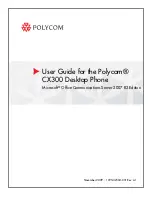
D14869.11
Codec C20 API Reference Guide TC7.0, JANUARY 2014.
Copyright © 2010–2014 Cisco Systems, Inc. All rights reserved.
12
Cisco TelePresence System Codec C20
API Reference Guide
xCommand ??
xCommand Audio Microphones Mute
xCommand Audio Microphones Unmute
xCommand Audio Sound Play
Sound(r): <Bump/Busy/CallDisconnect/CallInitiate/CallWaiting/Dial/KeyInput/KeyTone/Nav/NavBack/
Notification/OK/PresentationConnect/Ringing/SpecialInfo/TelephoneCall/VideoCall/Volume>
Loop: <On/Off>
.
.
.
xCommand Phonebook Folder Delete
FolderId(r): <S: 0, 255>
xCommand Phonebook Search
PhonebookId: <S: 0, 255>
PhonebookType: <Corporate/Local>
SearchString: <S: 0, 255>
SearchField: <Name/Number>
ContactType: <Any/Folder/Contact>
Offset: <0..65534>
FolderId: <S: 0, 255>
Limit: <0..65534>
Recursive: <False/True>
OK
xCommand ?
– User Commands –
Audio
Bookings
Boot
Call
CallHistory
CallLog
CamCtrlPip
Camera
Conference
Dial
DTMFSend
Experimental
FacilityService
FarEndControl
HttpFeedback
Key
Message
Phonebook
Presentation
Preset
Provisioning
Security
Standby
SystemUnit
Video
OK
Commands
Commands instruct the codec to execute actions, such as
to dial a number or to search the phone book. All commands
start with the prefix xCommand followed by a command path.
Writing
xCommand ?
on the command line will list all the top
level commands.
To view the complete list of commands and their parameters,
write
xCommand ??
on the command line.
Command arguments are key-value pairs. The
(r)
behind the
argument name indicates that the argument is required for
the command.
When issuing a xCommand, the command consists of one
argument and one required parameter.
Example: xCommand Dial Number: 123
• xCommand is the command prefix.
The command to be
executed is Dial.
• The example contains one argument, Number: 123.
Number is the key and 123 is its value. The key/value pair
is separated with ‘:’.
Contents
Introduction
About the API
xConfiguration
Appendices
xCommand
xStatus
About the API












































